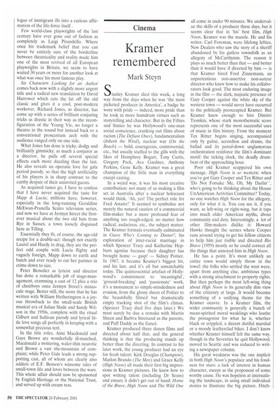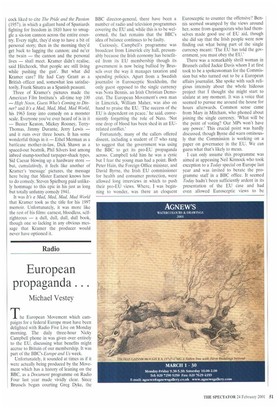Kramer remembered
Mark Steyn
Stanley Kramer died this week, a long way from the days when he was 'the most picketed producer in America', a badge he wore with pride — indeed, more pride than he took in more humdrum virtues such as storytelling and character. But in the Fifties and Sixties he was Hollywood's one-man social conscience, cranking out films about racism (The Defiant Ones), fundamentalism (Inherit the Wind), nuclear war (On the Beach) — bold, courageous, controversial, etc., but usually stuffed to the gills with the likes of Humphrey Bogart, Tony Curtis, Gregory Peck, Ava Gardner, Anthony Perkins, Gene Kelly. Kramer was a great champion of the little man in everything except casting.
In a weird way, it was his most creative contribution: not many of us making a film set in Australia after a nuclear holocaust would think, `Ah, yes! The perfect role for Fred Astaire!' It seemed to symbolise not merely the natural caution of a commercial film-maker but a more profound fear of anything too rough-edged, no matter how radical, audacious, etc., the subject matter. The Kramer formula eventually culminated in Guess Who's Coming to Dinner?, his exploration of inter-racial marriage in which Spencer Tracy and Katherine Hepburn agonise because their daughter has brought home — gasp! — Sidney Poitier. In 1967, it became Kramer's biggest hit, and his last, and it's all but unwatchable today. The quintessential artefact of Hollywood's commitment to 'meaningful', 'ground-breaking' and 'passionate' work, it's a monument to simple-mindedness and evasion, from the glossy sheen of Poitier to the beautifully filmed but dramatically empty tracking shot of the film's climax. (Spencer Tracy died five days later.) We must surely be due a remake with Martin Sheen and Barbra Streisand as the parents, and Puff Daddy as the fiancé.
Kramer produced three dozen films and directed about half that, and the general thinking is that the producing stands up better than the directing. In contrast to his later work, the young producer had an eye for fresh talent: Kirk Douglas (Champion), Marlon Brando (The Men) and Grace Kelly (High Noon) all made their first big impressions in Kramer pictures. He knew how to spot writing talent (including Dr Seuss) and ensure it didn't get out of hand: Home of the Brave, High Noon and The Wild One all come in under 90 minutes. We undervalue the skills of a producer these days, but it seems clear that in 'his' best film, High Noon, Kramer was the muscle. He and his writer, Carl Foreman, were lifelong lefties, New Dealers who saw the story of a sheriff abandoned by his gutless townsfolk as an allegory of McCarthyism. The reason it plays so much better than that — and better than it would have if directed by him — is that Kramer hired Fred Zinnemann, an unpretentious non-assertive non-auteur director who knew how to make his collaborators look good. The most enduring image in the film — the dark, majestic presence of Gary Cooper against the white sky of the western town — would never have occurred to the politically preoccupied Kramer. But Kramer knew enough to hire Dimitri Tiomkin, whose stark monothematic score represents one of the most successful uses of music in film history. From the moment Tex Ritter begins singing, accompanied only by guitar, accordion and drums, the ballad and its pared-down unglamorous orchestration reinforce the film's dominant motif: the ticking clock, the deadly drumbeat of the approaching hour.
Poor old Kramer scuppered his own message. High Noon is so western: when you've got Gary Cooper and Tex Ritter and 'Do Not Forsake Me, Oh, My Darlin', who's going to be thinking about the House UnAmerican Activities Committee? Today, no one watches High Noon for the allegory, only for what it is. You can see it, if you want, as left-wing or right-wing, but it taps into much older American myths, about community and duty. Interestingly, a lot of other film-makers dislike it: Howard Hawks thought the scenes where Cooper runs around trying to get his fellow citizens to help him just risible and directed Rio Bravo (1959) mostly so he could correct all the things that annoyed him in High Noon.
He has a point. It's most unlikely an entire town would simply throw in the towel: the folks who settled the west were, apart from anything else, ambitious types with a strong attachment to property rights. But then perhaps the most left-wing thing about High Noon is its generally dim view of the citizenry at large. It would become something of a unifying theme for the Kramer oeuvre. In a Kramer film, the wider community is generally a bunch of mean-spirited moral weaklings who loathe the protagonist for what he is, whether black or crippled, a decent dutiful marshal or a moody leatherclad biker. I don't know whether Kramer himself felt the same way, though in the Seventies he quit Hollywood, moved to Seattle and was reduced to writing a newspaper column.
His great weakness was the one implicit in both High Noon's populace and his fondness for stars: a lack of interest in human character, except as the proponent of some worthy cause. He was hopeless at internalising the landscape, in using small individual stories to illustrate the big picture. Hitch cock liked to cite The Pride and the Passion (1957). in which a gallant band of Spaniards fighting for freedom in 1810 have to smuggle a six-ton cannon across the entire country. Every night, they'd stop to have a bit of personal story; then in the morning they'd get back to lugging the cannon: and ne'er the twain — the cannon and the personal lives — shall meet. Kramer didn't realise, said Hitchcock, 'that people are still living while pushing the gun'. But what did Kramer care? He had Cary Grant as a British officer and, somewhat less satisfactorily, Frank Sinatra as a Spanish peasant.
Three of Kramer's pictures made the American Film Institute's all-time top 100
— High Noon, Guess Who's Coming to Dinner? and It's a Mad, Mad, Mad, Mad World, his 1963 foray into comedy on a monster scale. Everyone you've ever heard of is in it
— Buster Keaton, Mickey Rooney, TerryThomas, Jimmy Durante, Jerry Lewis — and it runs over three hours. It has some wonderful things in it — Ethel Merman as a battleaxe mother-in-law, Dick Shawn as a spaced-out beatnik, Phil Silvers lost among inbred stump-toothed tarpaper-shack types, Sid Caesar blowing up a hardware store — but, cumulatively, it feels like another of Kramer's 'message' pictures, the message here being that Mister Earnest knows how to do comedy. Steven Spielberg paid unlikely hommage to this epic in his just as long but totally unfunny comedy 1941.
It was It's a Mad, Mad, Mad, Mad World that Kramer took as the title for his 1997 memoir. Unfortunately, it was more like the rest of his films: earnest, bloodless. selfrighteous — a dull, dull, dull, dull book. though one so lacking in any obvious message that Kramer the producer would never have optioned it.



































































 Previous page
Previous page